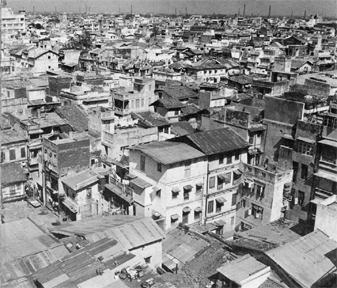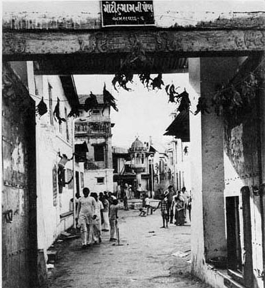Apr 14, 2025
Apr 14, 2025
by Snehal Shah
 Architecture has always been a mirror to the social structure of a society. With horrific communal violence, that has claimed hundreds of lives, breaking out in India's western state of Gujarat at the beginning of March, it is important to examine the role of architecture in conflict.
Architecture has always been a mirror to the social structure of a society. With horrific communal violence, that has claimed hundreds of lives, breaking out in India's western state of Gujarat at the beginning of March, it is important to examine the role of architecture in conflict.
Ehsan Jafri, a former Member of Parliament, who was burnt alive with over 15 of his relatives in the communal carnage in Ahmedabad (Gujarat's premier city), perhaps got one thing right but another wrong.
He had chosen, like several other Ahmedabadis, to build his home in a residential complex in which all the houses belonged to people from his own religious community. Unfortunately, the housing complex happened to be surrounded by similar complexes dominated by the 'other' community.
This segregation along religious lines, however, is not something that Ahmad Shah had in mind when he founded Ahmedabad in 1411 on the eastern banks of the Sabarmati river. At that time, the city was an irregular semi-circular structure, defined by fortified walls that played an important role in the defence of the entire city.
 Over the centuries, the city expanded and it took both its geography and economic system from the respective trades being followed by its people. The issue of separation of areas on the basis of religious faiths played no role in its planning - a point which can be substantiated from the inner city of Ahmedabad, which has tombs and mosques located all over, as if distributed equally.
Over the centuries, the city expanded and it took both its geography and economic system from the respective trades being followed by its people. The issue of separation of areas on the basis of religious faiths played no role in its planning - a point which can be substantiated from the inner city of Ahmedabad, which has tombs and mosques located all over, as if distributed equally.
Three hundred years after it was founded, the city got a unique architectural feature - Pols - which can still be seen in some parts of old Ahmedabad.
A Pol is a small residential unit consisting of a single street with a group of houses, which is usually protected by a massive gate at the entrance. When the gate is closed, the entire street becomes one big house often inhabited by people of the same trade or even by relatives. For instance, the centre of the city is considered to be the Gheevala Pol (originally inhabited by people in the business of clarified butter) around which many areas evolved, like the Pathan Pol (moneylenders) and the Chippa Pol, which is dominated by weavers.
A compact housing cluster with dead-end streets forms a distinctive residential pattern within a Pol. In earlier days, the Pols were self-sustaining for a certain period of time since each house had its own underground storage for water, and food grains were stored in the safest part of the house. At times, two different Pols opened for ventilation at the same point and they also had a common service bay for drainage, water supply and garbage collection.
These Pols formed a kind of micro-neighborhood, which developed further as population density increased in the city.
But in 1714, when communal riots broke out, these Pols also acquired a religious identity. After the riots, Ahmedabad's population sought greater security by living together in closely associated groups within the Pols. Whereas earlier, religious segregation occurred naturally because of occupations, this was the first time that a conscious attempt was made by religious communities to live together, to seek security in numbers.
In recent times, it has been the Pols that have taken on a distinct communal character. This primarily has to do with the fact that invariably people from the same trade also follow the same religion. For instance, those in the business of clarified butter are Hindus and moneylenders are Muslims.
In such a scenario, the Pols, which were meant to enhance community living as well as provide security to the occupants, have proved to be fatal for many victims of communal riots. For instance, the small back service streets (called Chhini) ended up being literal dead-ends during the riots of 1969 and 1992.
Moreover, thanks to the structure of the Pols it is easy to throw a plastic bottle full of petrol or even a 'kakra' - a crude missile made out of rolling a cloth ball with pieces of metal dipped in petrol and then lit - from one Pol area into another. Not only do such home made weapons inflict maximum damage because of the density of the population, it is impossible for the police to trace the people who indulge in these violent activities.
Hence, even though the Pol and Chhini were architecturally useful structures, they now play a significant role in fanning communal violence in the city.
The proximity of the houses brings another critical issue to the fore - the central courtyard is vulnerable to attack from all the sides, both in Muslim dominated areas like Jamalpur and Hindu dominated areas like Khadia, where communal riots have broken out in recent times.
At another level, after the unforgettable riots of 1969, the city was also divided on purely communal lines - the Hindus started migrating to the western side with the Muslims taking more control of the walled city, irrespective of the particular trade they were engaged in.
Gujarat, however, is not alone when it comes to such divisions in structural planning. For instance, Brooklyn in New York, and Soho in London are dangerous areas for anyone not belonging to the area. The divisions here are, however, not on religious lines but on the colour of the skin.
In another similarity, the lanes and by-lanes in these areas are used for spreading violence, with very little chances of the miscreants being caught. Like the Chhinis in Ahmedabad, these lanes, now neglected and full of garbage, were once designed to provide services like drainage, sewerage, water supply and gas lines.
In the 19th century, much thought went into the planning of the Champs d' Elysses and other boulevards of Paris. The objective of creating wide roads - cutting through the old, fiercely independent residential quarters of Paris with their narrow lanes - was to control public uprisings and make army access to these areas easier. Since that period, this planning strategy has been carried forward by dictatorial regimes to control urban populations.
Architecture and town planning reflect the social and political structure of a society. For instance, all over Europe there have always been distinct squares - the church square and the palace square - two major powers which may otherwise have clashed, have thus been physically separated.
Even in London, the newer areas were planned keeping in mind the need to separate groups, which had the potential for conflict. Hence North London was for the elite and the place for power and South London for the working classes. Moreover, in London the church square (St Paul Cathedral) and the palace square (Trafalgar Square) leading to the Buckingham Palace too are at a distance.
But whether such architectural segregation can work in a country like India is doubtful. And the recent communal riots in Gujarat only make this doubt stronger.
17-Mar-2002
More by : Snehal Shah

|
It only description of the Past & Present condition with the drama of the words....nothing new thought / solutions for what can be done for the happy / better future through the architecture / urban planning for restoring heritage values & buildings ( habitats )... |